typedef定义的函数指针
C语言typedef用法总结

C语言typedef用法总结黄海涛,2012-3-11C语言中的typedef可以让人感觉很清新,但也可以让人感觉神秘。
当你一层层剥开它的时候,神秘的面纱终会摘下……让我们一起来探究其中的秘密吧!一、概述1、类型定义符typedefC语言提供了一个称为typedef的工具,它允许你为各种数据类型定义新的名字。
定义形式:typedef 原类型名新类型名;它的格式与变量声明完全一样,只是把typedef这个关键字放在声明的前面,但typedef并不创建变量,而是为指定类型引入一个新的名字。
2、实质其实质是:为现有类型取个新名字,它并没有引入新的类型。
typedef是一种声明形式,它为一种类型引入新的名字,而不是产生新的类型,也不会为变量分配空间。
3、作用时机在某些方面,typedef类似于宏文本替换,但typedef是类型定义符,在编译时会有相应类型的检查。
typedef是由编译器解释的。
▲typedef与#define的区别A.#define后面没有分号,而typedef后面有分号;B.#define不是关键字,而typedef是关键字;C.宏定义中宏名紧跟着#define,而typedef中的类型名并不紧接其后;D.可以用其他类型说明符对宏名进行扩展,但对typedef定义的类型名却不行;例如:E.在连续几个变量声明中,typedef定义的类型名可以保证声明中所有的变量均为同一种类型,而#define定义的宏名则无法保证。
4、使用原因1)表达方式更简洁,简化编程;2)使程序参数化,提高程序的可移植性;3)为程序提供更好的说明性,可以引入一个易记且意义明确的新名字,提升可维护性。
5、缺点允许一些看上去混乱的语法,可以把几个声明放在一个声明中。
如:二、使用typedef声明定义时的限制1、2、3、存储类关键字:auto、extern、register、static与typedef但在存储类说明符中,typedef是个例外,它不会真正影响对象的存储特性。
C++typedef用法详解

C++typedef⽤法详解转⾃,经过整理typedef的语法描述在现实⽣活中,信息的概念可能是长度,数量和⾯积等。
在C语⾔中,信息被抽象为int、float和 double等基本数据类型。
从基本数据类型名称上,不能够看出其所代表的物理属性,并且int、float和double为系统关键字,不可以修改。
为了解决⽤户⾃定义数据类型名称的需求,C 语⾔中引⼊类型重定义语句typedef,可以为数据类型定义新的类型名称,从⽽丰富数据类型所包含的属性信息。
typedef的语法描述typedef 类型名称类型标识符;typedef为系统保留字,“类型名称”为已知数据类型名称,包括基本数据类型和⽤户⾃定义数据类型,“类型标识符”为新的类型名称。
例如: typedef double LENGTH;typedef unsigned int COUNT;定义新的类型名称之后,可像基本数据类型那样定义变量。
例如:typedef unsigned int COUNT;unsigned int b;COUNT c;typedef 的主要应⽤形式typedef 的主要应⽤有如下的⼏种形式:1) 为基本数据类型定义新的类型名。
2) 为⾃定义数据类型(结构体、公⽤体和枚举类型)定义简洁的类型名称。
3) 为数组定义简洁的类型名称。
4) 为指针定义简洁的名称。
为基本数据类型定义新的类型名typedef unsigned int COUNT;typedef double AREA;此种应⽤的主要⽬的,⾸先是丰富数据类型中包含的属性信息,其次是为了系统移植的需要,稍后详细描述。
为⾃定义数据类型(结构体、公⽤体和枚举类型)定义简洁的类型名称。
例如:struct Point{double x;double y;double z;};struct Point oPoint1={100,100,0};struct Point oPoint2;其中结构体struct Point为新的数据类型,在定义变量的时候均要有保留字struct,⽽不能像int和double那样直接使⽤Point来定义变量。
C++的#define,typedef,extern的使用
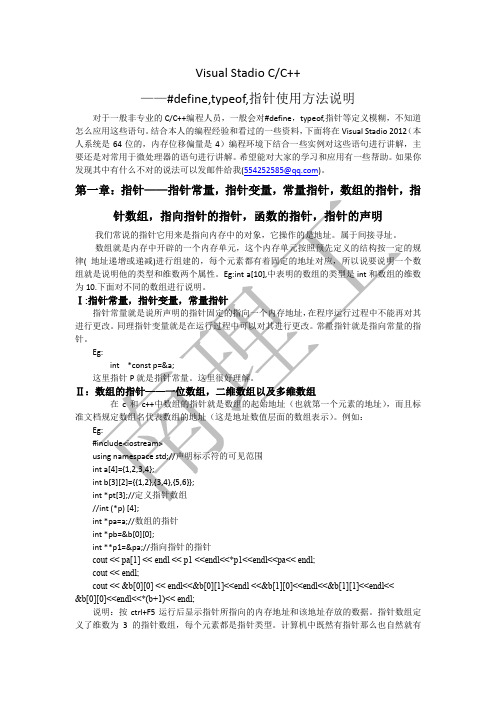
} double *p=&NJUPT::money; double (*p)()=&NJUPT::getMoney():
Ⅳ:类成员的指针
类成员和一般的外部变量相互比较,不同就是它所在的域不同,这个域很重要,它决 定了该变量可以使用的范围。那么一个指针如果要指向类的成员函数或者成员变量,那么除 了要表达它的返回类型、参数列表或者类型之外,那么还要说明它所指向的变量(或者函数)
的域,为了说明该域我们要使用类域限定: class njust
Visual Stadio C/C++
——#define,typeof,指针使用方法说明
对于一般非专业的 C/C++编程人员,一般会对#define,typeof,指针等定义模糊,不知道 怎么应用这些语句。结合本人的编程经验和看过的一些资料,下面将在 Visual Stadio 2012(本 人系统是 64 位的,内存位移偏量是 4)编程环境下结合一些实例对这些语句进行讲解,主 要还是对常用于微处理器的语句进行讲解。希望能对大家的学习和应用有一些帮助。如果你 发现其中有什么不对的说法可以发邮件给我(554252585@)。
int *ptr; ptr = MALLOC ( 5, int ); 将这宏展开以后的结果:ptr = (int *) malloc ( (5) * sizeof(int) ); 这个例子是宏定义的经典应用之一,完成了函数不能完成的功能,但是宏定义也不 能滥用,通常,如果相同的代码需要出现在程序的几个地方,更好的方法是把它实 现为一个函数。 (2)下面总结宏和函数的不同之处,这段总结摘自《C 和指针》一书。
typedef定义函数类型

typedef定义函数类型本⽂转载于:最近在看posix实时信号时,遇到⼀处函数是如此定义的:[cpp]1. typedef void sigfunc_rt(int, siginfo_t *, void *);在我常规理解⾥,⼀般定义⼀个函数类型都是这样定义的:[cpp]1. typedef void (*sighandler_t)(int);2. sighandler_t signal(int signum, sighandler_t handler);其实对于函数,typedef有两类⾃定义类型:⾸先我们要先明⽩⼀个概念,函数名是不是指针?也就是说⼀个函数名可不可以代表⼀个地址?以及什么是函数类型?经过查找,函数名就是⼀个指针,但是意义是不⼀样的,如同于数组a[],a和&a其实都是⼀样的。
当调⽤⼀个函数时,我们都是直接⽤函数名调⽤,或者说通过指针调⽤。
函数类型,在我理解,就是定义了⼀个函数返回值类型以及参数类型。
那么:1.tpyedef⾃定义函数指针类型:[cpp]1. #include <stdio.h>2. typedef int (*fp_t)(char c);3.4. int f0(char c) { printf("f0, c = %c\n", c); return 0;}5. int f1(char c) { printf("f1, c = %c\n", c); return 1;}6.7. int main()8. {9. int ret;10. fp_t fp;11. fp = f0;12. ret = fp('a');13. fp = f1;14. ret = fp('x');15. return 0;16. }运⾏结果:f0, c = af1, c = x2.typedef⾃定义函数类型:[cpp]1. #include <stdio.h>2. typedef int fp_t(char c);3.4. int f0(char c) { printf("f0, c = %c\n", c); return 0;}5. int f1(char c) { printf("f1, c = %c\n", c); return 1;}6.7. int main()8. {9. int ret;10. fp_t* fp;11. fp = f0;12. ret = fp('a');13. fp = f1;14. ret = fp('x');15. return 0;16. }运⾏结果:f0, c = af1, c = x。
qt中typedef的用法
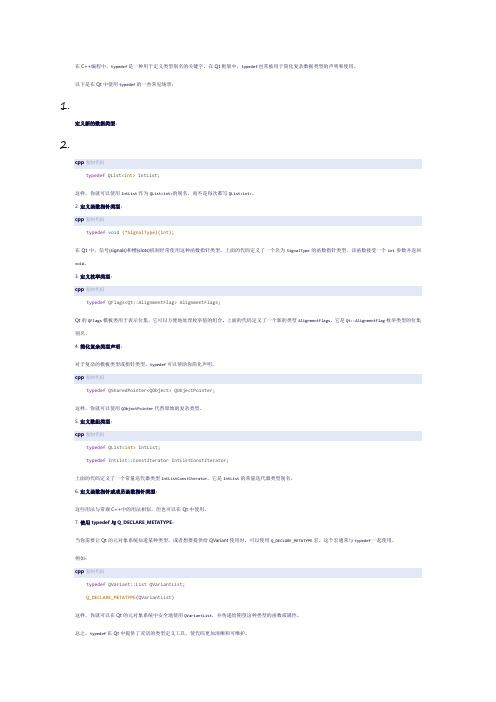
在C++编程中,typedef是一种用于定义类型别名的关键字。
在Qt框架中,typedef也常被用于简化复杂数据类型的声明和使用。
以下是在Qt中使用typedef的一些常见场景:1.定义新的数据类型:2.cpp复制代码typedef QList<int> IntList;这样,你就可以使用IntList作为QList<int>的别名,而不是每次都写QList<int>。
2. 定义函数指针类型:cpp复制代码typedef void(*SignalType)(int);在Qt中,信号(signals)和槽(slots)机制经常使用这种函数指针类型。
上面的代码定义了一个名为SignalType的函数指针类型,该函数接受一个int参数并返回void。
3. 定义枚举类型:cpp复制代码typedef QFlags<Qt::AlignmentFlag> AlignmentFlags;Qt的QFlags模板类用于表示位集,它可以方便地处理枚举值的组合。
上面的代码定义了一个新的类型AlignmentFlags,它是Qt::AlignmentFlag枚举类型的位集别名。
4. 简化复杂类型声明:对于复杂的模板类型或指针类型,typedef可以帮助你简化声明。
cpp复制代码typedef QSharedPointer<QObject> QObjectPointer;这样,你就可以使用QObjectPointer代替原始的复杂类型。
5. 定义数组类型:cpp复制代码typedef QList<int> IntList;typedef IntList::ConstIterator IntListConstIterator;上面的代码定义了一个常量迭代器类型IntListConstIterator,它是IntList的常量迭代器类型别名。
6. 定义函数指针或成员函数指针类型:这些用法与常规C++中的用法相似,但也可以在Qt中使用。
typedefine 函数指针

typedefine 函数指针函数指针是C语言中的一个重要概念,它可以让程序在运行时动态地选择调用某个函数。
在C语言中,函数指针的定义使用了typedef 关键字,可以将函数指针类型起一个新的名字,从而提高代码的可读性和可维护性。
函数指针的定义形式如下:typedef 返回值类型 (*函数指针名字)(参数列表);其中,返回值类型是函数的返回值类型,函数指针名字是我们为函数指针起的新名字,参数列表是函数的参数列表。
通过typedef关键字,我们可以将函数指针类型起一个新的名字,使得代码更加易读。
函数指针可以作为函数的参数或者返回值,这在C语言中非常常见。
通过函数指针,我们可以动态地选择调用不同的函数,从而实现程序的灵活性和可扩展性。
在C语言中,函数指针可以用于回调函数的实现。
回调函数是指一个函数作为参数传递给另一个函数,在特定的事件发生时被调用。
通过函数指针,我们可以实现事件和相应函数的解耦,使得程序更加灵活和可扩展。
函数指针还可以用于实现函数的动态加载。
在某些情况下,我们需要在运行时根据条件选择调用不同的函数,这时可以使用函数指针。
通过函数指针,我们可以根据条件选择加载不同的函数,从而实现程序的动态性和可配置性。
函数指针的使用需要注意一些细节。
首先,函数指针的类型必须和被调用函数的类型匹配,否则会导致编译错误。
其次,函数指针可以指向任意类型的函数,包括有返回值和无返回值的函数,参数个数和类型也可以不同。
在使用函数指针时,我们可以通过函数指针调用函数,也可以通过函数指针获取函数的地址,从而实现函数的传递和调用。
函数指针的调用方式与普通函数调用相同,只是需要通过函数指针来调用。
函数指针是C语言中的一个重要概念,它可以提高程序的灵活性和可扩展性。
通过函数指针,我们可以动态地选择调用不同的函数,实现回调函数和函数的动态加载等功能。
函数指针的使用需要注意一些细节,但是只要掌握了基本的用法,就可以灵活地应用于实际的程序中。
typedef函数指针的定义和使用方法说明
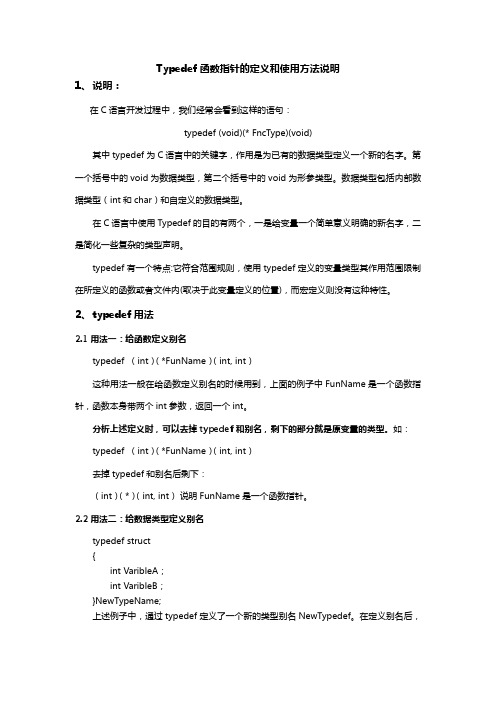
2、 typedef 用法
2.1 用法一:给函数定义别名 typedef (int) (*FunName) (int, int) 这种用法一般在给函数定义别名的时候用到,上面的例子中 FunName 是一个函数指 针,函数本身带两个 int 参数,返回一个 int。 分析上述定义时,可以去掉 typedef 和别名,剩下的部分就是原变量的类型。如: typedef (int) (*FunName) (int, int) 去掉 typedef 和别名后剩下: (int) (*) (int, int) 说明 FunName 是一个函数指针。 2.2 用法二:给数据类型定义别名 typedef struct { int VaribleA; int VaribleB; }NewTypeName; 上述例子中,通过 typedef 定义了一个新的类型别名 NewTypedef。在定义别名后,
Calculation GetFunctionAddr(char option) //获取对应运算的函数地址 { switch(option) { case 1: return(AddCalc); case 2: return(SubCalc); default: return(NULL); } } main() { int Varible1 = 1; int Varible2 = 2; //定义函数指针,存放函数地址 Calculation fp = GetFunctionAddr(1);
可以通过以下的步骤优化: //定义每一个 case 对应的处理函数 void HandleCase1(void) { 功能 1; } ….. void HandleCase100(void) { 功能 100; } typedef (void)(*HandleCaseFcn)(void); HandleCaseFcn FcnName[]
c++的typedef的用法
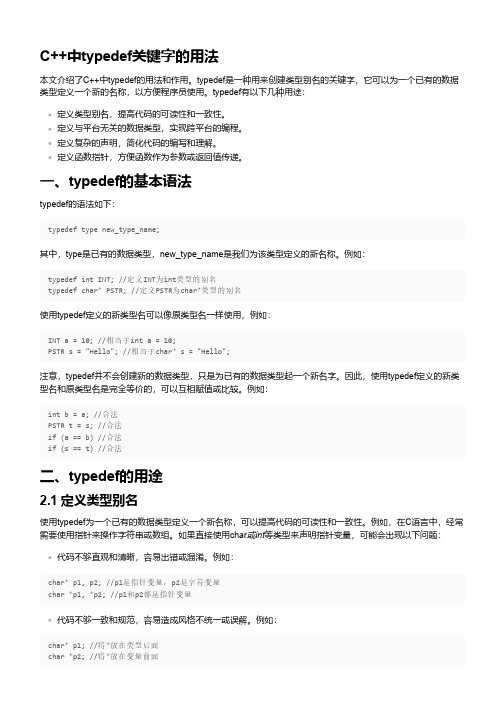
C++中typedef关键字的用法本文介绍了C++中typedef的用法和作用。
typedef是一种用来创建类型别名的关键字,它可以为一个已有的数据类型定义一个新的名称,以方便程序员使用。
typedef有以下几种用途:定义类型别名,提高代码的可读性和一致性。
定义与平台无关的数据类型,实现跨平台的编程。
定义复杂的声明,简化代码的编写和理解。
定义函数指针,方便函数作为参数或返回值传递。
一、typedef的基本语法typedef的语法如下:typedef type new_type_name;其中,type是已有的数据类型,new_type_name是我们为该类型定义的新名称。
例如:typedef int INT; //定义INT为int类型的别名typedef char* PSTR; //定义PSTR为char*类型的别名使用typedef定义的新类型名可以像原类型名一样使用,例如:INT a = 10; //相当于int a = 10;PSTR s = "Hello"; //相当于char* s = "Hello";注意,typedef并不会创建新的数据类型,只是为已有的数据类型起一个新名字。
因此,使用typedef定义的新类型名和原类型名是完全等价的,可以互相赋值或比较。
例如:int b = a; //合法PSTR t = s; //合法if (a == b) //合法if (s == t) //合法二、typedef的用途2.1 定义类型别名使用typedef为一个已有的数据类型定义一个新名称,可以提高代码的可读性和一致性。
例如,在C语言中,经常需要使用指针来操作字符串或数组。
如果直接使用char或int等类型来声明指针变量,可能会出现以下问题:代码不够直观和清晰,容易出错或混淆。
例如:char* p1, p2; //p1是指针变量,p2是字符变量char *p1, *p2; //p1和p2都是指针变量代码不够一致和规范,容易造成风格不统一或误解。
C语言typedef的使用

C语言typedef的使用C语言typedef的使用typedef 关键字能帮助你简化复杂的定义并让你的代码简洁可靠,当然,可靠这一点我还是持保留态度,因人而异吧。
具体是如何使用呢?以下仅供参考!具体方法如下:C 语言提供typedef 关键字,允许你为已经存在的类型起一个新的名字,有一点需要注意,typedef 仅仅是为已经存在的类型创建了一个新的名字而已,不是创建新的类型。
首先将typedef 关键字放在前面,接着是已经存在的类型名,接着是新的名字:typedef existing_type new_name;举个例子,如果你想为unsinged integer 创建一个新的名叫score 的类型,你仅需要使用这样使用 typedef :typedef unsigned int score;后面你就可以使用“新类型” score 来声明变量,例如:score high_score;当然你还可以同时定义多个变量typedef int aaa, bbb, ccc;typedef int ar[15], arr[9][6];typedef char c, *cp, carr[100];/* 下面定义一些对象 *//* 都是int */aaa int1;bbb int2;ccc int3;ar yyy; /* 容量为15的整型数组 */arr xxx; /* 9*6 阶的整型数组 */c ch; /* 一个字符 */cp pnt; /* 指向字符的指针 */carr chry; /* 容量为100的字符数组 */C 语言 typedef 的使用这里来看一下使用typedef的好处,假如有一天你想将 unsigned int 修改成更大的数据类型,比如unsigned long,而此时你的很多代码文件都使用了unsigned int,如果没有使用typedef,你得到处都修改一遍,十分麻烦。
如果使用了之前的定义,这时只需修改score 一处就行,是不是很方便?另一个使用typedef 来增强可靠性的例子是size_t,size_t 是sizeof 操作符指定类型的大小,其基于目标处理器的运算能力而不是内存能力。
函数指针typedef 模板

函数指针typedef 模板1. 函数指针typedef的定义函数指针typedef可以理解为为函数指针类型起一个别名。
在C语言中,函数指针指向一个函数的位置区域,可以通过该指针调用相应的函数。
使用typedef可以使得函数指针类型的声明更加简洁、易读。
2. 函数指针typedef的语法在C语言中,函数指针typedef的语法如下所示:```ctypedef 返回类型 (*指针名称)(参数列表);```其中,返回类型表示指向函数的返回值类型,指针名称为函数指针的别名,参数列表表示函数的形参列表。
3. 函数指针typedef的使用函数指针typedef可以通过以下几个步骤来定义和使用:(1) 定义一个函数指针类型的typedef,指定返回类型和参数列表。
```ctypedef int (*FuncPtr)(int, int);```(2) 使用typedef定义的函数指针类型来声明函数指针变量。
```cFuncPtr ptr; // 声明一个名为ptr的函数指针变量```(3) 将函数的位置区域赋给函数指针变量,并通过该指针调用函数。
```cint add(int a, int b) {return a + b;}ptr = add; // 将add函数的位置区域赋给ptrint result = ptr(3, 5); // 通过ptr调用add函数,得到结果8```4. 函数指针typedef的优点使用函数指针typedef的好处在于可以提高代码的可读性和可维护性。
通过为函数指针类型起一个别名,可以使得函数指针的声明和使用变得更加清晰明了,减少了代码中函数指针类型的重复出现,同时也提高了代码的可维护性。
5. 函数指针typedef的应用场景函数指针typedef广泛应用于各种复杂的系统和框架中,特别适用于回调函数的定义和使用。
回调函数通常作为参数传递给其他函数,通过函数指针回调来实现特定的功能。
函数指针和typedef用法
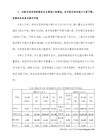
int (*func)(int *p);
首先找到变量名func,外面有一对圆括号,而且左边是一个*号,这说明func是一个指针;然后跳出这个圆括号,先看右边,又遇到圆括号,这说明(*func)是一个函数,所以func是一个指向这类函数的指针,即函数指针,这类函数具有int*类型的形参,返回值类型是int。
14 printf("%p\n", add); /* 输出add的值 */
15 printf("%p\n", &add); /* 输出add的地址 */
16 printf("%p\n", fp); /* 输出fp的值 */
// 和一个字符变量;
以下则可行:
typedef char* PCHAR;
PCHAR pa, pb;
用途二:
用在旧的C代码中,帮助struct。以前的代码中,声明struct新对象时,必须要带上struct,即形式为: struct 结构名对象名,如:
二十一天学通C语言:函数型指针
本文节选自《21天学通C语言》一书
C程序中的函数也都是存放在代码区内的,它们同样也是有地址的。那么如何取得函数的地址呢?在前面也说过函数定义的时候实际上是定义了一个函数变量,那么是否可以将函数变量赋值给其他变量呢?回答这些问题需要涉及另外一个概念:函数型指针。按照已有的指针的知识,顾名思义,函数型指针就是指向函数的指针。如果有一个函数声明为:
【范例14-7】使用函数型指针来调用函数,实现方法如示例代码14-7所示。
示例代码14-7
01 #include <stdio.h>
02
03 int add(const int a, const int b) { /* 定义add函数 */
使用typedef定义函数类型和函数指针
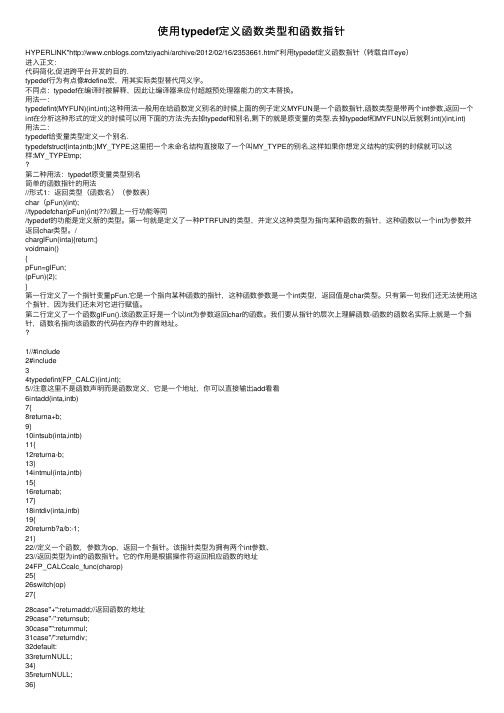
typedefint(MYFUN)(int,int);这种用法一般用在给函数定义别名的时候上面的例子定义MYFUN是一个函数指针,函数类型是带两个int参数,返回一个 int在分析这种形式的定义的时候可以用下面的方法:先去掉typedef和别名,剩下的就是原变量的类型.去掉typedef和MYFUN以后就剩:int()(int,int) 用法二:
? =>"typedefdoubleMYDOUBLE"中MYDOUBLE是类型double的一个typedef-name。 ? MYDOUBLE???d;<=>d是一个double类型的变量 ? [例2] ? typedefdoubleDp;? ? 分析: ? 去掉typedef?,得到正常变量声明=>doubleDp; ? 变量Dp的类型为double,即pointertodouble; ? =>"typedefdoubleDp"中Dp是类型double的一个typedef-name。 ? Dp???dptr;<=>dptr是一个pointertodouble的变量 ? [例3] ? typedefintFunc(int); ? 分析: ? 去掉typedef?,得到正常变量声明=>intFunc(int); ? 变量Func的类型为一个函数标识符,该函数返回值类型为int,参数类型为int; ? =>"typedefintFunc(int)"中Func是函数类型(函数返回值类型为int,参数类型为int)的一个typedef-name。 ? Func???fptr;<=>fptr是一个pointertofunctionwithoneintparameter,returningapointertoint ? Func????f;??这样的声明意义就不大了。 ? [例4] ? typedefint(PFunc)(int); ? 分析: ? 去掉typedef?,得到正常变量声明=>int(PFunc)(int); ? 变量PFunc的类型为一个函数指针,指向的返回值类型为int,参数类型为int的函数原型; ?
c语言结构体指针 typedef

C语言中的结构体指针与typedef一、结构体指针的概念结构体是C语言中一种复合类型,它由若干数据成员组成,我们可以通过定义结构体变量的方式来使用结构体类型。
当我们需要在函数间传递结构体变量或在函数中动态创建结构体变量时,就需要使用结构体指针来进行操作。
二、结构体指针的定义和使用1. 定义结构体指针在C语言中,我们可以通过在结构体类型名称前加上"*"来定义结构体指针。
如果我们有一个名为Student的结构体类型,我们可以定义一个指向Student类型的指针变量ptr_stu如下所示:```struct Student {char name[20];int age;};struct Student *ptr_stu;```2. 结构体指针的初始化和使用我们可以通过使用取位置区域符""将结构体变量的位置区域赋给结构体指针,然后可以通过指针来访问结构体的成员变量。
假设我们有一个名为stu的结构体变量:```struct Student stu = {"John", 20};struct Student *ptr_stu = stu;printf("Name: s\n", ptr_stu->name);printf("Age: d\n", ptr_stu->age);```而在实际开发中,如果结构体类型名称较长或者需要频繁使用结构体指针,我们可以通过使用typedef来定义结构体指针类型,从而简化代码并提高可读性。
三、typedef关键字的介绍typedef是C语言中的关键字之一,它可以用来为一个已有的数据类型定义一个新的名称。
通过使用typedef,我们可以为复杂的数据类型定义更简洁、更易读的别名,从而提高代码的可维护性和可读性。
四、结构体指针的typedef用法1. 定义结构体指针类型我们可以通过使用typedef来定义结构体指针类型,从而可以直接使用新的类型名称来声明结构体指针变量。
typedef定义函数类型的用法

typedef定义函数类型的用法typedef是C语言中的一个关键字,用于定义新的数据类型名称,其中一个重要的用途是定义函数类型,即通过一个函数类型名称来代替函数指针类型,使代码更加简洁易读。
函数类型的定义格式为:typedef 返回值类型 (*函数类型名称)(参数类型列表);其中,括号内的部分表示函数指针类型,类似于int *(*p)(int),表示一个指向返回值类型为int*,参数类型为int的函数指针变量p。
而函数类型名称则是我们自己定义的一个名称,可以代替指针变量p,并且不需要每次都写出返回值类型和参数类型列表。
例如,下面的代码用typedef定义了一个函数类型为fun_type的函数类型:```typedef int (*fun_type)(int, int);```这条语句表示fun_type是一个函数类型名称,可以代替返回值类型为int,参数类型列表为(int, int)的函数指针类型。
因此,下面的代码:```int add(int a, int b) {return a + b;}fun_type f = add;```与下面的代码是等价的:```int add(int a, int b) {return a + b;}int (*f)(int, int) = add;```但是,使用函数类型名称会更加简洁易懂,因为它把函数指针类型的声明包装成了一个自定义类型。
这样,我们可以很容易地定义一个函数指针数组:```fun_type funcs[2] = {add, sub};int result = funcs[0](1, 2); // result == 3```而不用写出完整的函数指针类型,使代码看起来更加清晰和紧凑。
除了typedef定义普通函数类型外,还可以定义回调函数类型,即用于传递给其他函数作为参数的函数类型。
这里不再赘述,有兴趣的读者可以自行查阅相关资料。
总之,typedef定义函数类型可以让我们创建更加优雅的函数指针变量和数组,使代码更加清晰易懂。
结构体内函数指针
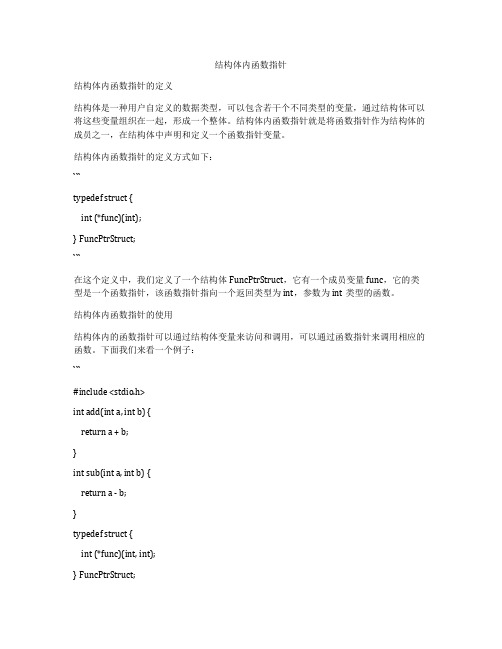
结构体内函数指针结构体内函数指针的定义结构体是一种用户自定义的数据类型,可以包含若干个不同类型的变量,通过结构体可以将这些变量组织在一起,形成一个整体。
结构体内函数指针就是将函数指针作为结构体的成员之一,在结构体中声明和定义一个函数指针变量。
结构体内函数指针的定义方式如下:```typedef struct {int (*func)(int);} FuncPtrStruct;```在这个定义中,我们定义了一个结构体FuncPtrStruct,它有一个成员变量func,它的类型是一个函数指针,该函数指针指向一个返回类型为int,参数为int类型的函数。
结构体内函数指针的使用结构体内的函数指针可以通过结构体变量来访问和调用,可以通过函数指针来调用相应的函数。
下面我们来看一个例子:```#include <stdio.h>int add(int a, int b) {return a + b;}int sub(int a, int b) {return a - b;}typedef struct {int (*func)(int, int);} FuncPtrStruct;int main() {FuncPtrStruct funcPtr;funcPtr.func = add;printf("Add function result: %d\n", funcPtr.func(3, 5));funcPtr.func = sub;printf("Subtract function result: %d\n", funcPtr.func(3, 5));return 0;}```在这个例子中,我们首先定义了两个函数add和sub,然后定义了一个结构体FuncPtrStruct,它包含一个函数指针成员变量func。
接着在主函数中,我们定义了一个FuncPtrStruct类型的变量funcPtr,然后分别将add和sub函数的地址赋值给funcPtr.func,最后通过funcPtr.func来调用相应的函数。
CC++函数指针(typedef简化定义)
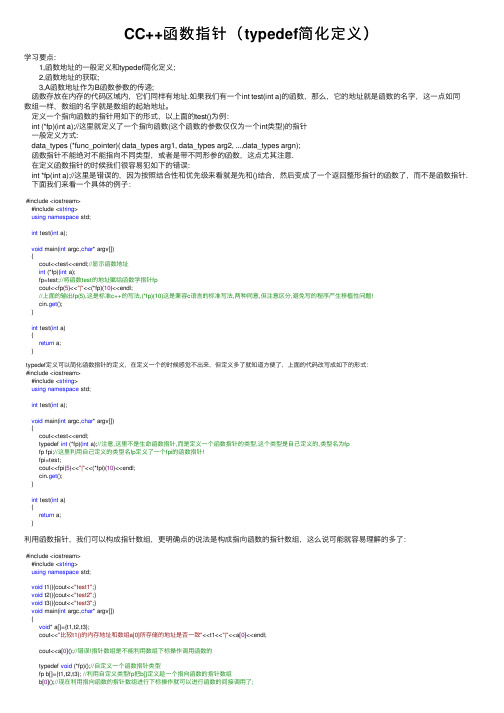
CC++函数指针(typedef简化定义)学习要点:1,函数地址的⼀般定义和typedef简化定义;2,函数地址的获取;3,A函数地址作为B函数参数的传递;函数存放在内存的代码区域内,它们同样有地址.如果我们有⼀个int test(int a)的函数,那么,它的地址就是函数的名字,这⼀点如同数组⼀样,数组的名字就是数组的起始地址。
定义⼀个指向函数的指针⽤如下的形式,以上⾯的test()为例:int (*fp)(int a);//这⾥就定义了⼀个指向函数(这个函数的参数仅仅为⼀个int类型)的指针⼀般定义⽅式:data_types (*func_pointer)( data_types arg1, data_types arg2, ...,data_types argn);函数指针不能绝对不能指向不同类型,或者是带不同形参的函数,这点尤其注意.在定义函数指针的时候我们很容易犯如下的错误:int *fp(int a);//这⾥是错误的,因为按照结合性和优先级来看就是先和()结合,然后变成了⼀个返回整形指针的函数了,⽽不是函数指针.下⾯我们来看⼀个具体的例⼦:#include <iostream>#include <string>using namespace std;int test(int a);void main(int argc,char* argv[]){cout<<test<<endl;//显⽰函数地址int (*fp)(int a);fp=test;//将函数test的地址赋给函数学指针fpcout<<fp(5)<<"|"<<(*fp)(10)<<endl;//上⾯的输出fp(5),这是标准c++的写法,(*fp)(10)这是兼容c语⾔的标准写法,两种同意,但注意区分,避免写的程序产⽣移植性问题!cin.get();}int test(int a){return a;}typedef定义可以简化函数指针的定义,在定义⼀个的时候感觉不出来,但定义多了就知道⽅便了,上⾯的代码改写成如下的形式:#include <iostream>#include <string>using namespace std;int test(int a);void main(int argc,char* argv[]){cout<<test<<endl;typedef int (*fp)(int a);//注意,这⾥不是⽣命函数指针,⽽是定义⼀个函数指针的类型,这个类型是⾃⼰定义的,类型名为fpfp fpi;//这⾥利⽤⾃⼰定义的类型名fp定义了⼀个fpi的函数指针!fpi=test;cout<<fpi(5)<<"|"<<(*fpi)(10)<<endl;cin.get();}int test(int a){return a;}利⽤函数指针,我们可以构成指针数组,更明确点的说法是构成指向函数的指针数组,这么说可能就容易理解的多了:#include <iostream>#include <string>using namespace std;void t1(){cout<<"test1";}void t2(){cout<<"test2";}void t3(){cout<<"test3";}void main(int argc,char* argv[]){void* a[]={t1,t2,t3};cout<<"⽐较t1()的内存地址和数组a[0]所存储的地址是否⼀致"<<t1<<"|"<<a[0]<<endl;cout<<a[0]();//错误!指针数组是不能利⽤数组下标操作调⽤函数的typedef void (*fp)();//⾃定义⼀个函数指针类型fp b[]={t1,t2,t3}; //利⽤⾃定义类型fp把b[]定义趁⼀个指向函数的指针数组b[0]();//现在利⽤指向函数的指针数组进⾏下标操作就可以进⾏函数的间接调⽤了;cin.get();}仔细看上⾯的例⼦可能不⽤我多说⼤家也会知道是怎么⼀会事情了,最后我们做⼀个重点⼩结,只要记住这⼀点,对于理解利⽤函数指针构成数组进⾏函数间接调⽤就很容易了!void* a[]={t1,t2,t3};cout<<"⽐较t1()的内存地址和数组a[0]所存储的地址是否⼀致"<<t1<<"|"<<a[0]<<endl;cout<<a[0]();//错误!指针数组是不能利⽤数组下标操作调⽤函数的上⾯的这⼀⼩段中的错误⾏,为什么不能这么调⽤呢?前⼀篇教程我们已经说的很清楚了,不过在这⾥我们还是复习⼀下概念,指针数组元素所保存的只是⼀个内存地址,既然只是个内存地址就不可能进⾏a[0]()这样地址带括号的操作,⽽函数指针不同它是⼀个例外,函数指针只所以这么叫它就是因为它是指向函数指向内存的代码区的指针,它被系统授予允许与()括号操作的权利,进⾏间接的函数调⽤,既然函数指针允许这么操作,那么被定义成函数指针的数组就⼀定是可以⼀样的操作的。
c++的typedef的用法
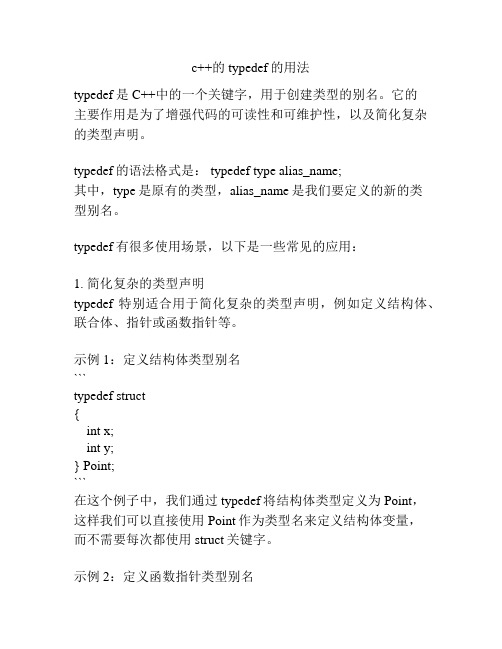
c++的typedef的用法typedef是C++中的一个关键字,用于创建类型的别名。
它的主要作用是为了增强代码的可读性和可维护性,以及简化复杂的类型声明。
typedef的语法格式是: typedef type alias_name;其中,type是原有的类型,alias_name是我们要定义的新的类型别名。
typedef有很多使用场景,以下是一些常见的应用:1. 简化复杂的类型声明typedef特别适合用于简化复杂的类型声明,例如定义结构体、联合体、指针或函数指针等。
示例1:定义结构体类型别名```typedef struct{int x;int y;} Point;```在这个例子中,我们通过typedef将结构体类型定义为Point,这样我们可以直接使用Point作为类型名来定义结构体变量,而不需要每次都使用struct关键字。
示例2:定义函数指针类型别名```typedef int (*PtrFunc)(int, int);```这个例子中,我们通过typedef将函数指针类型定义为PtrFunc,这样我们可以直接使用PtrFunc作为类型名来声明函数指针变量,而不需要每次都写出完整的函数指针类型声明。
2. 提高代码的可读性和可维护性使用typedef可以使代码更加易读,特别是当我们使用复杂的类型或者嵌套类型时。
通过给类型名起一个更具描述性的别名,可以使代码更加清晰和易于理解。
示例3:使用typedef改进代码可读性```typedef std::vector<std::map<std::string, int>> DataSet;```在这个例子中,我们使用typedef给std::vector<std::map<std::string, int>>这个复杂的类型定义了一个别名DataSet。
这样,在程序的其他地方,我们只需要使用DataSet就可以代替这个复杂的类型,使代码更加清晰、简洁。
C中typedef函数指针的使用

C中typedef函数指针的使⽤类型定义的语法可以归结为⼀句话:只要在变量定义前⾯加上typedef,就成了类型定义。
这⼉的原本应该是变量的东西,就成为了类型。
int integer; //整型变量int *pointer; //整型指针变量int array [5]; //整型数组变量int *p_array [5]; //整型指针的数组的变量int (*array_pointer) [5];//整型数组的指针的变量int function (int param);//函数定义,也可将函数名看作函数的变量int *function (int param);//仍然是函数,但返回值是整型指针int (*function) (int param);//现在就是指向函数的指针了若要定义相应类型,即为类型来起名字,就是下⾯的形式:typedef int integer_t; //整型类型typedef int *pointer_t; //整型指针类型typedef int array_t [5]; //整型数组类型typedef int *p_array_t [5]; //整型指针的数组的类型typedef int (*array_pointer_t) [5]; //整型数组的指针的类型typedef int function_t (int param); //函数类型typedef int *function_t (int param); //函数类型typedef int (*function_t) (int param); //指向函数的指针的类型注意:上⾯的函数类型在C中可能会出错,因为C中并没有函数类型,它的函数变量会⾃动退化成函数指针;在C++中好像是可以的。
在这⾥主要说明的是形式上的相似性.typedef的⼀般形式为:typedef 类型定义名;注意:上述⼀般形式中最后的分号不可缺少!在编程中使⽤typedef⽬的⼀般有两个,⼀个是给变量⼀个易记且意义明确的新名字,另⼀个是简化⼀些⽐较复杂的类型声明。
typedef函数指针

typedef函数指针typedef函数指针,又称为类型定义函数指针,它是指向函数的指针,是一种数据类型,它可以定义一个名称,用于存储指向特定函数的指针。
由于函数指针本身也是变量,因此可以存储在另一个指针中或者作为普通变量使用。
函数指针与普通变量不同,其存储的是函数的地址而不是函数本身,因此函数指针可以被用来实现函数指针数组,实现函数的指针传参,还可以用于回调函数等应用场合。
typedef函数指针是用typedef关键字定义的,其语法如下:typedef回类型 (*函数指针名称)(参数列表)typedef函数指针可以指向任何函数,它的定义与普通函数的声明类似,只是在函数的前面加上一个星号。
下面是一个简单的例子: // 一个函数指针typedef int (*func_ptr)(int, int);//义一个函数int add(int a, int b){return a + b;}// 使用定义的函数指针func_ptr fp;fp = &add;int result = fp(2, 3); //用add函数typedef可以用来定义指向函数的指针,但是它不能用来定义函数本身,也不能修改函数的参数列表,也不能改变函数的返回类型。
函数指针的应用有很多,其中最重要的是实现函数指针数组和函数指针传参。
函数指针数组的应用有很多,它可以用来存储可供不同对象调用的函数,还可以实现不同类型的选择结构,例如switch-case 语句。
函数指针传参则可以用来传递不同类型的函数给调用者,例如使用排序算法时可以传递基于数值大小判断的函数指针。
函数指针还可以用于回调函数,在C/C++中,回调函数是一种可以在特定时钟运行的函数,它可以被调用并提供参数。
回调函数一般用作插件函数,回调函数的使用有助于实现解耦,将用户的代码与框架的代码分离开。
函数指针也可以用来实现函数重载,函数重载可以帮助我们改善代码可读性,它可以让我们使用同一函数名分别实现不同参数类型的功能,但是由于C/C++不支持函数重载,我们可以使用typedef函数指针来实现函数重载同样的功能。
结构体中定义函数指针的方法
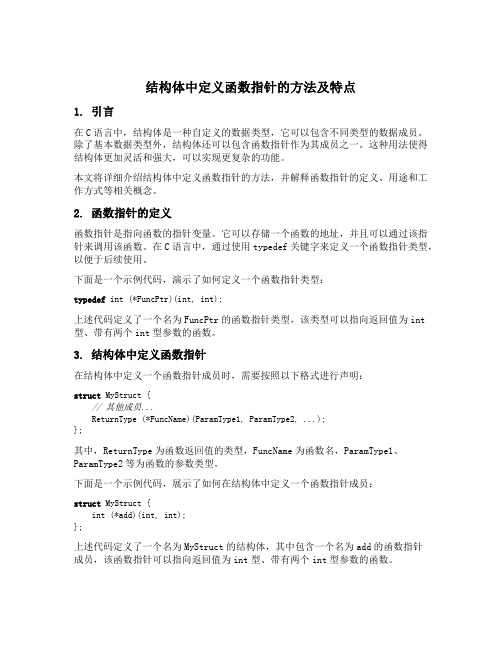
结构体中定义函数指针的方法及特点1. 引言在C语言中,结构体是一种自定义的数据类型,它可以包含不同类型的数据成员。
除了基本数据类型外,结构体还可以包含函数指针作为其成员之一。
这种用法使得结构体更加灵活和强大,可以实现更复杂的功能。
本文将详细介绍结构体中定义函数指针的方法,并解释函数指针的定义、用途和工作方式等相关概念。
2. 函数指针的定义函数指针是指向函数的指针变量。
它可以存储一个函数的地址,并且可以通过该指针来调用该函数。
在C语言中,通过使用typedef关键字来定义一个函数指针类型,以便于后续使用。
下面是一个示例代码,演示了如何定义一个函数指针类型:typedef int (*FuncPtr)(int, int);上述代码定义了一个名为FuncPtr的函数指针类型,该类型可以指向返回值为int 型、带有两个int型参数的函数。
3. 结构体中定义函数指针在结构体中定义一个函数指针成员时,需要按照以下格式进行声明:struct MyStruct {// 其他成员...ReturnType (*FuncName)(ParamType1, ParamType2, ...);};其中,ReturnType为函数返回值的类型,FuncName为函数名,ParamType1、ParamType2等为函数的参数类型。
下面是一个示例代码,展示了如何在结构体中定义一个函数指针成员:struct MyStruct {int (*add)(int, int);};上述代码定义了一个名为MyStruct的结构体,其中包含一个名为add的函数指针成员,该函数指针可以指向返回值为int型、带有两个int型参数的函数。
4. 函数指针的用途结构体中定义函数指针的方法提供了一种灵活和可扩展的方式来实现多态性。
通过在结构体中定义不同类型的函数指针成员,可以在运行时动态地选择调用不同的函数实现。
4.1 回调函数回调函数是一种常见的使用场景,它允许将某个特定功能作为参数传递给其他函数,并在需要时进行调用。
- 1、下载文档前请自行甄别文档内容的完整性,平台不提供额外的编辑、内容补充、找答案等附加服务。
- 2、"仅部分预览"的文档,不可在线预览部分如存在完整性等问题,可反馈申请退款(可完整预览的文档不适用该条件!)。
- 3、如文档侵犯您的权益,请联系客服反馈,我们会尽快为您处理(人工客服工作时间:9:00-18:30)。
变量 Foo_t 的类型为 struct { ... // } ;
=> "typedef struct { ... // } Foo_t "中 Foo_t 是"struct { ... // }"的一个 typedef-name。 这里 struct {...//}是一个无"标志名称(tag name)"的结构体声明。
[例 1]
typedef double MYDOUBLE; 分析: 去掉 typedef ,得到正常变量声明=> double MYDOUBLE; 变量 MYDOUBLE 的类型为 double; => "typedef double MYDOUBLE"中 MYDOUBLE 是类型 double 的一个 typedef-name。 MYDOUBLE d; <=> d 是一个 double 类型的变量 [例 2]
再谈 typedef(重点为函数指针)
有种很方便的写法。
typedef int *p; p pointer; 这时直接把 pointer 带入原式中,取代 p 然后去掉 typedef,得到的结果就是 int * pointer; 哈哈,这样直接替换就很直观多了。
C 语言语法简单,但内涵却博大精深;如果在学习时只是止步于表面,那么往往后期 会遇到很多困难。typedef 是 C 语言中一个很好用的工具,大量存在于已有代码中,特别值 得一提的是:C++标准库实现中更是对 typedef 有着大量的使用。但很多初学者对其的理解 仅局限于:typedef 用来定义一个已有类型的"别名(alias)"。正是因为有了这样的理解,才有 了后来初学者在 typedef int myint 和 typedef myint int 之间的犹豫不决。很多国内大学的 C 语言课之授课老师也都是如是说的,或者老师讲的不够透彻,导致学生们都是如是理解的。 我这里想结合 C 语言标准文档以及一些代码实例,也说说 typedef。
#include "iostream"
using namespace std;
int add(int a,int b){ return (a+b); }
typedef int (* func)(int ,int ) ;
void main(){ func f = add; int n = f(1,2); cout << n << endl; }
typedef int* Func(int); 分析: 去掉 typedef ,得到正常变量声明=> int* Func(int); 变量 Func 的类型为一个函数标识符,该函数返回值类型为 int*,参数类型为 int;
=> "typedef int* Func(int)"中 Func 是函数类型(函数返回值类型为 int*,参数类型为 int) 的一个 typedef-name。
参照这段描述,并拿 typedef int *p 作为例子来理解:在一个声明中,如果有存储 类说明符 typedef 的修饰,标识符 p 将被定义为了一个 typedef name,这个 typedef name 表示(denotes)一个类型,什么类型呢?就是 int *p 这个声明(declarator)中标识符 (indentifier)p 的类型(int*)。
Func *fptr; <=> fptr 是一个 pointer to function with one int parameter, returning a pointer to int
Func f; 这样的声明意义就不大了。 [例 4]
typedef int (*PFunc)(int); 分析: 去掉 typedef ,得到正常变量声明=> int (*PFunc)(int); 变量 PFunc 的类型为一个函数指针,指向的返回值类型为 int,参数类型为 int 的函数 原型; => "typedef int (*PFunc)(int)"中 PFunc 是函数指针类型(该指针类型指向返回值类型为 int,参数类型为 int 的函数)的一个 typedef-name。 PFunc fptr; <=> fptr 是一个 pointer to function with one int parameter, returning int
[例 5]
typedef int A[5]; 分析: 去掉 typedef ,得到正常变量声明 => int A[5];
变量 A 的类型为一个含有 5 个元素的整型数组; => "typedef int A[5]"中 A 是含有 5 个元素的数组类型的一个 typedef-name。 A a = {3, 4, 5, 7, 8}; A b = { 3, 4, 5, 7, 8, 9}; /* 会给出 Warning: excess elements in array initializer */ [例 6] typedef int (*A)[5]; (注意与 typedef int* A[5]; 区分) 分析: 去掉 typedef ,得到正常变量声明 => int (*A)[5]; 变量 A 的类型为 pointer to an array with 5 int elements; => "typedef int (*A)[5]"中 A 是"pointer to an array with 5 int elements"的一个 typedef-name。 int c[5] = {3, 4, 5, 7, 8}; A a = &c; printf("%d\n", (*a)[0]); /* output: 3 */ 如果这样赋值: int c[6] = {3, 4, 5, 7, 8, 9}; A a = &c; /* 会有 Warning: initialization from incompatible pointer type */ [例 7] typedef struct _Foo_t Foo_t; 分析: 去掉 typedef ,得到正常变量声明 => struct _Foo_t Foo_t; 变量 Foo_t 的类型为 struct _Foo_t; => "typedef struct _Foo_t Foo_t"中 Foo_t 是"struct _Foo_t"的一个 typedef-name。 [例 8] typedef struct { ... // } Foo_t; 分析: 去掉 typedef ,得到正常变量声明 => struct { ... // } Foo_t;
typedef double *Dp; 分析: 去掉 typedef ,得到正常变量声明=> double *Dp; 变量 Dp 的类型为 double*,即 pointer to double; => "typedef double *Dp"中 Dp 是类型 double*的一个 typedef-name。 Dp dptr; <=> dptr 是一个 pointer to double 的变量 [例 3]
为了巩固上面的理解,我们再来看看"C 语言参考手册(C: A Reference Manual)"中的说 法:任何 declarator(如 typedef int *p)中的 indentifier(如 p)定义为 typedef-name, 其(指 代 p)表示的类型是 declarator 为正常变量声明(指代 int *p)的那个标识符(指代 p)的类型 (int*)。有些绕嘴,不过有例子支撑:
int *p; 这样的代码是 C 语言中最最基础的一个语句了,大家都知道这个语句声明了一个变量 p,其类型是指向整型的指针(pointer to int);如果在这个声明的前面加上一个 typedef 后, 整个语义(semantics)又会是如何改变的呢?
typedef int *p; 我们先来看看 C99 标准中关于 typedef 是如何诠释的?C99 标准中这样一小段精辟的 描述:"In a declaration whose storage-class specifier is typedef, each declarator defines an identifier to be a typedef name that denotes the type specified for the identifier in the way described in xx"。
再对一下两个声明:
int *p;
typedef int *p;
是不是有点"茅舍顿开"的感觉,int *p 中, p 是一个变量,其类型为 pointer to int;在 int *p 前面增加一个 typedef 后,p 变为一个 typedef-name,这个 typedef-name 所表示的类型 就是 int *p 声明式中 p 的类型(int*)。说句白话,typedef 让 p 去除了普通变量的身份,摇身 一变,变成了 p 的类型的一个 typedef-name 了。
